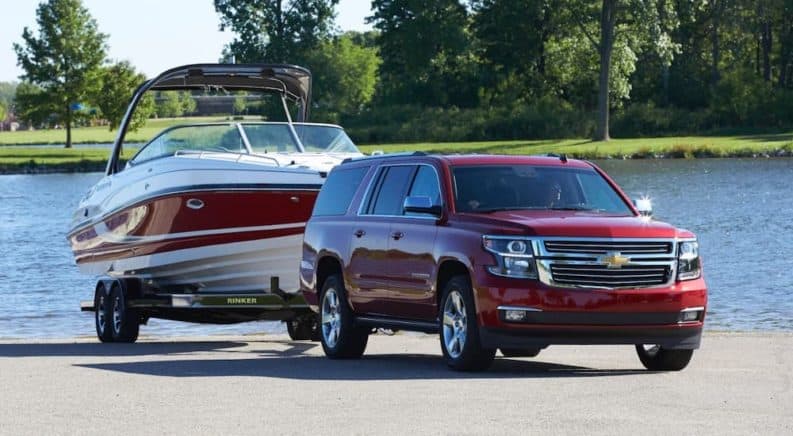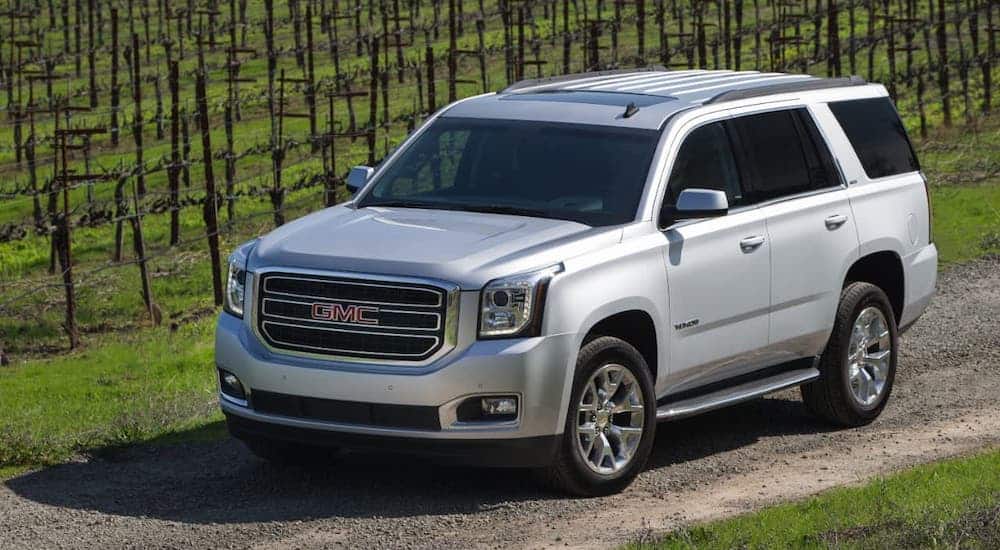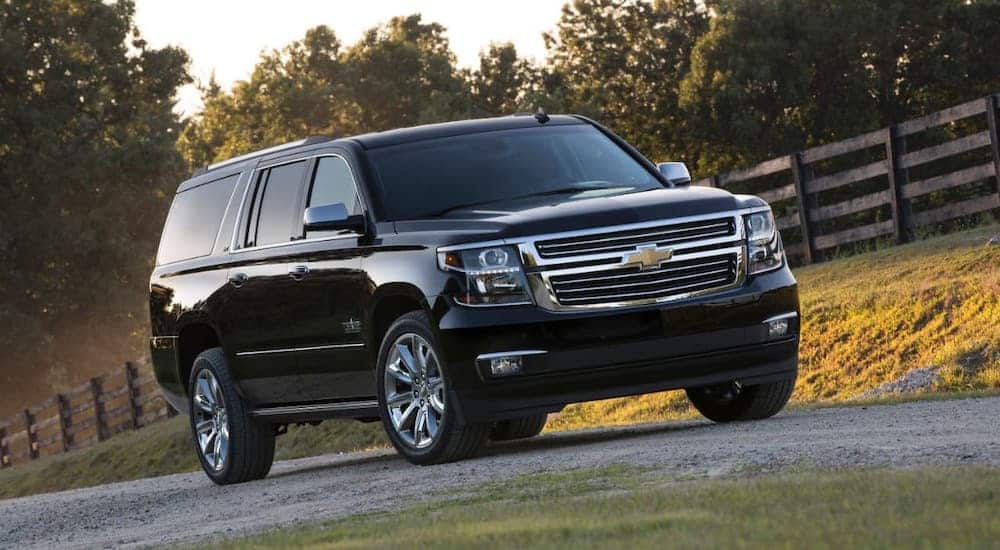When shopping for a used three-row SUV, drivers may have a hard time determining which model best fits their budget, lifestyle, and driving needs. A used Chevy Suburban is an obvious choice, with the combination of Chevrolet’s reputation and the Suburban’s long history on the SUV market (it is actually the longest-running automobile model in history). But what about a used Yukon XL? GMC’s three-row offering seems to be lingering in the Suburban’s shadow, but is there a reason behind this? In general, it’s because the Suburban offers the same capabilities as the Yukon XL at a lower price, giving it better overall value.
It’s easy to experience a little confusion when comparing Chevrolet and GMC products. Both brands exist under the General Motors umbrella of manufacturers, so are they competitors? Are they partners? With several Chevrolet and GMC products sharing nearly-identical design and engineering, understanding the differences when shopping for a used SUV can be somewhat mind-boggling. Still, as with any vehicle shopping experience, there can only be one choice that is perfect for your needs. Let’s take a look at some of the most popular used Yukon XL and Suburban models to get a feel for which SUV might make the best investment for your driving future.
A Little Background on the Yukon XL and Suburban
Both the GMC Yukon XL and the Chevrolet Suburban have a long and rich history. According to popular lore, the term “Suburban” was used to describe a variety of large, enclosed, station wagon type vehicles from several manufacturers, including both Chevrolet and GMC. The Chevrolet Suburban, first known as the “Suburban Carryall” hit the US markets in 1934, while GMC’s iteration first appeared in 1937. Interestingly, both brands originally shared the Suburban name, and the “Yukon” nameplate did not appear until the 2000 model year rebranding.
Over the years, Chevy’s Suburban has evolved from a station wagon-type vehicle intended to move equal parts passengers and cargo to the three-row, nine-passenger, towing-ready SUV the American public knows and loves. GMC’s Yukon dwells in the same niche, with the towing capability of a small truck and considerable space for passengers and cargo.
Following its rebranding in 2000, the Yukon XL received great critical acclaim from both automobile experts and real-life drivers alike. The models of this year were known for having “warehouse-like” interiors while shaving a few inches off of the overall body size. At the same time, the Chevy Suburban was losing favor among the American public. While it continued to provide loads of room and plenty of capability for both daily use and road trip adventures, some felt the interior was growing a bit stale and predictable. Still, while competitors arrived and faded away, both the Yukon XL and the Suburban remained at the top of the pack in the three-row SUV niche.
An Almost Classic Value: The 2007 Yukon XL and Suburban
By 2007, both the GMC Yukon XL and Chevy Suburban were ready for a full refresh and makeover. The first change GMC made to the 2007 Yukon XL was an improved chassis that combined strength and capability with a smoother ride, cleaner handling, and greater efficiency. Key safety features for the model year include airbags for all three rows, electronic stability control to prevent dreaded rollovers, and rear parking assist, which was standard on upper trims.
The 2007 Yukon XL cuts a great bargain on many used car lots, as many exciting options were offered during the first year of this generation. The standard engine offered on most trims is a 5.3L V8 that provides 320 horsepower and 340 lb-ft of torque. A flex-fuel version of this engine also appeared in 2007. Drivers could choose an optional 6.0L V8, which increases the Yukon’s productivity to 352 horsepower and 384 lb-ft torque. The top 2007 Denali trim includes a souped-up 6.2L V8 with a mighty 380 horsepower and 415 lb-ft of torque.
Yukon XL trims included SLE, SLT, and the Denali, and a heavy-duty 2500 version was added to the line, with an increased towing capacity of nearly 10,000 pounds. Standard features across the lineup included heated power mirrors, roof rails, privacy glass, and side steps for easy entrance and exit. Upper trims included leather upholstery, power-adjustable bucket seats or heated captain’s chairs, and rain-sensing automatic windshield wipers. Demonstrating the rapid advancement of technology at the time, Denali Yukons included a Bose 10 speaker sound system, 6 CD changer, and XM Satellite radio. Optional features included a rearview camera system, power liftgate, and remote start.
The Chevrolet Suburban received a highly-praised interior upgrade in 2007, though the focus of the Suburban’s popularity is its 9,700-pound towing capacity, 137 cubic feet of cargo space, and four-wheel drive. The standard engine on the 2007 Suburban is also a 5.3L V8 with a flex fuel option. The 6.0L V8 is a popular option, providing identical power to the Yukon’s offering. A 2500 version of the Suburban was also available in 2007, which included its own iron-block 6.0L V8, providing 352 horsepower and 383 lb-ft of torque.
The 2007 Suburban appears in three main trims – the LS, LT, and LTZ – as well as three LT sub-trims consisting of the LT1, LT2, and LT3. Standard equipment includes side steps, OnStar capability, heated mirrors, remote keyless entry, and daytime running lights. As the trims advance, the Suburban gains heated bucket seats in the place of split-bench seats in the first and second row, power-folding second-row seats and liftgate, leather upholstery, and a premium sound system.
A Z71 Off-Road package also joined the 2007 Suburban lineup, which added platinum chrome appearance details, as well as off-road-ready tires and recovery hooks. Other options included a DVD entertainment system, rear parking assistance, and the touchscreen navigation screen drivers appreciate today.
Comparing the 2015 Generation of Yukon XL and Suburban
The next refresh and redesign for both the GMC Yukon XL and the Chevy Suburban occurred in 2015. The 2500 model of each SUV was dropped, with power and performance streamlined along each model’s lineup.
The 2015 Yukon XL gained much from the technological advances that had occurred throughout the previous generation. While the 2007 version still offers the typical “SUV grumble,” the 2015 version is notably silent and smooth. The optional folding second-row seats of the 2007 Yukon became power-folding second and third-row seats. Safety and driver assistance features, such as front and rear parking sensors, forward collision alert, and lane-departure warning, joined the lineup as well.
While the 5.3L V8 engine may sound familiar, the 2015 Yukon’s version includes direct fuel injection, Active Cylinder Management, and other engineering feats that improve fuel economy while boosting power. The result is a mightier 355 horsepower and 380 lb/-ft of torque. The top Denali trim again includes a mighty 6.2L V8, which has been tweaked to provide 420 horsepower and 460 horsepower.
The 2015 Suburban was also remodeled with greater luxury and comfort. Updated safety features are parcelled out by trim level, with the base LS trim including rear parking sensors, while the LT adds forward collision alert and lane departure warning. The top LTZ trim comes fully equipped with blind-spot monitoring and rear cross traffic alerts added to the mix.
However, only one engine is offered for the 2015 Suburban: the 5.3L V8 shared with the GMC Yukon. Interestingly enough, Chevy based this decision on the selling power of previous engine options. Noting that bigger engines were not selling as well, the efforts focused instead on creating a powerful Suburban with the best selling engine, which included upgrading to the same chassis employed by the Chevy Silverado pickup truck.
Choosing Your SUV
While it may be hard to decide whether the Chevy Suburban and GMC Yukon XL are close cousins or best frenemies, they are undeniably two of the best used SUVs that you can buy. It’s clear to see why these massive SUVs have stood the test of time, with drivers eagerly looking forward to new models and carefully scouting used models nearby. However, the Suburban has maintained a healthy lead over the Yukon thanks to its value proposition. While the GMC product tends to be slightly flashier with a few extra features, the Chevy offers the same platform and capabilities at a more affordable price. While you can’t go wrong with either, the Suburban will generally be the better buy.






